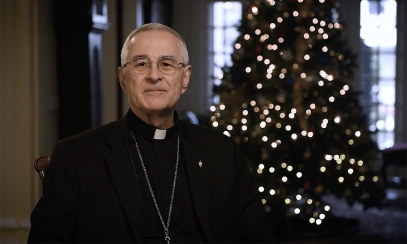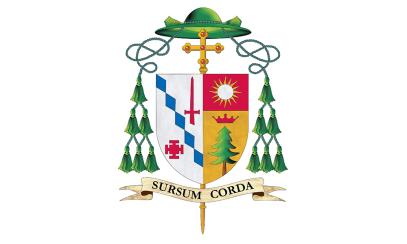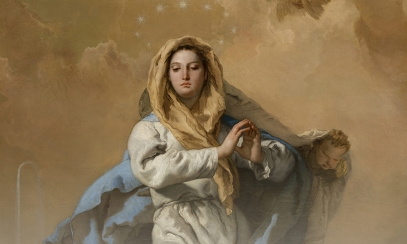
Heritage Offers Resolve to Move Forward
Bishop Raica Celebrates the Second Sunday of Lent
Bishop Raica Celebrates the Second Sunday of Lent
On March 13, Bishop Raica celebrated Mass at the Cathedral of St. Paul, marking the Second Sunday of Lent. The complete text of his homily follows herein.
On March 13, Bishop Raica celebrated Mass at the Cathedral of St. Paul, marking the Second Sunday of Lent. The complete text of his homily follows herein.
My sisters and brothers, at the outset, especially during our common Lenten journey of conversion and personal transformation, our prayers continue in earnest for the families and those impacted by the Russian – Ukraine war. In a particular way, we pray for the conversion of hearts away from chaos, violence, anguish, and destruction and for a return to diplomacy and international brotherhood. Together we are part of one human family whose members bear the unique image of God.
Some of you may know that I come from a background and heritage that’s 50 – 50. 50% Italian and 50% Polish. Mom was from Italian ancestry, from the Piemonte or Turin region, and dad was of Polish ancestry, northeast of Kraków. I am rightfully proud of my background and heritage. And, of course, growing up in Michigan’s Upper Peninsula, the U.P. as we called it, has been the point of reference all my life whether our family eats pasties, pasta, or pierogi. In recent years, it has been a real blessing to have spent quality time in both countries exploring where my ancestors lived. It has told me a great deal about “who I am,” knowing something about my familial roots. I know now that I have a lot of questions for my grandparents when I see them in the next life.
Whenever I go to the doctor, he asks those telling questions: “What’s happened in your family since the last time I saw you? Did anyone have a stroke or heart attack? What was their relation to you?” Medical histories are important to understand the potential health risks and inclinations one may have so that our primary care doctors can be pro-active in treatment and prevention.
Even in our communities, history lurks at every corner as we contemplate tearing down certain buildings that keep community memories alive or enshrine our values.
Knowing something about our past – even and especially our religious past – helps to ground us in our faith. It helps us to know why we pray the way we do, why we believe the way we do, why we live life the way we do. It helps to see the growth of the Church, the Body of Christ as an anchor, a north star, a true compass.
It has rightly been observed that one cannot determine where one is going until one knows where one has been. We don’t keep looking back, we must move forward.
Today’s Gospel passage moves us from the desert where we heard about the temptations of Christ to the mountain top; from a Christ who goes into the solitude of the wilderness to solidify His mission to the mountain where He reveals His true nature to an awestruck group of His closest disciples and companions.
Jesus is transfigured, we are told. They are visited by Elijah and Moses – historical figures. The disciples do see this as they glimpse momentarily the extraordinary, unbelievable, inexplicable experience of Christ in all His radiant glory right before their eyes. This experience would ground them after His death and resurrection with the certainty that Jesus is who He says He is.
Nevertheless, there is a danger here that Peter underscores: we often are tempted to freeze the action into a nostalgic moment and make a museum of our experience rather than using it as a validating reminder. Elijah and Moses appear – anchors of the past to demonstrate the continuity of Christ’s mission as He leads His band of disciples to Jerusalem. It entails God’s wonderful relationship with His Chosen People where all will be transformed and transfigured into a foundation for God’s new relationship through Jesus Christ with everyone – a new world where Christ and His Kingdom, that no human power can destroy, is established.
This transformation is vital today. Each person here has a splendid heritage; our families have a sacred story; the faith journey of every Christian has a hallowed legacy. We take these moments to inform our new resolve and purpose and move where the Lord is challenging us – to move into the deep, always forward.
Finally, we see that our background undergirds our courage. Heritage itself gives us strength to go on when it seems we cannot.
A writer described his experience of walking with his dad on Sunday afternoons. Tiring soon, dad would encourage him, “Let’s keep going. It’s only a little farther.” So, they would keep going, looking at the familiar landmarks that indicated they were almost home. One day, the son asked, “Dad, how much farther is ‘farther’?” Dad answered, “‘Farther’ is farther than you can see, but never as far as you can go!”
For Christ, Jerusalem was a little farther ahead, yet He did not stop there. He went as far as He could, giving His life on the cross, rising from the dead in triumph so that we, too, could continue and go on. A part of Jesus’ strength was derived from the examples of Moses, Elijah and all those who had gone before. Jesus went much farther, indeed. In His journey, our eternal life found its guarantee. It is beyond the horizon of our sight, but not beyond the grace God gives us to arrive at our destination as we keep our eyes “fixed on Him” – farther than we can see, but not as far as we can go.
Jesus never hurried past His heritage. Neither should we. We need to keep pressing on, looking for that conversion of heart that will change and shape us to live as Christ is calling us to live – being agents for good, joyful agents of mercy. For even as we live our lives following Christ, we, here at the Cathedral of St. Paul, both parishioners and visitors, represent a mosaic of stories, of faith experiences, of hurts and joys, hopes and dreams. St. Paul, of course, in the second reading knew of our Lord’s mercy in a direct way. It was a surprising presence that changed everything. It is something we look for too: Someone who will be present, who will listen, who will comfort and console, someone who will celebrate our life high points and catch us when we are faltering, someone who will lift us up when we have fallen. It is to know that I am deeply loved by God. He wants me to be with Him for eternity. He has something great in store for me. He’s invited us to share the Good News with others. He’s given us this example! So, we’ve gone into the desert. We’ve climbed the mountain. We’ve experienced Christ in His solitude and then in His radiant splendor. Our faith today is a vivid reminder that God still reveals Himself and from which we hear the voice of God clearly proclaim, “This is my beloved Son, listen to Him.”



